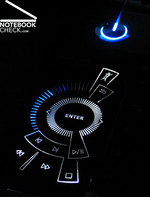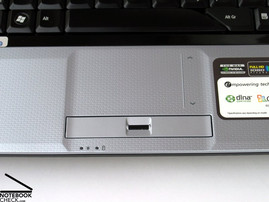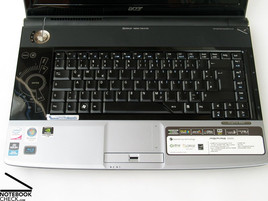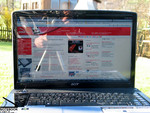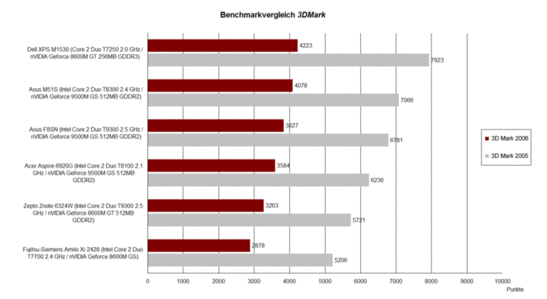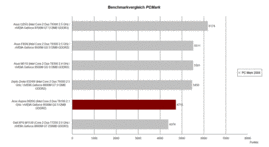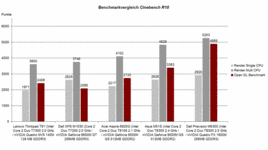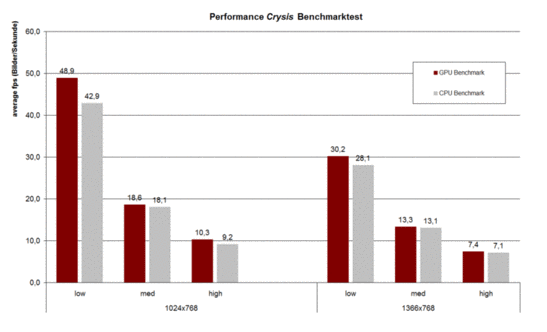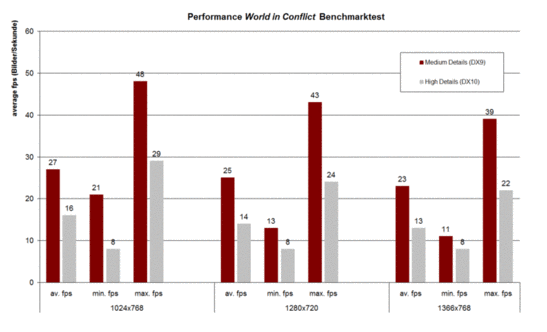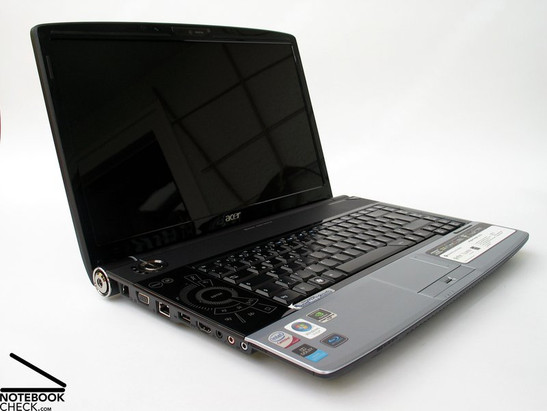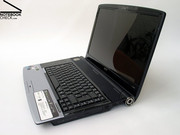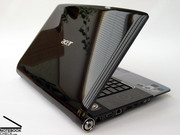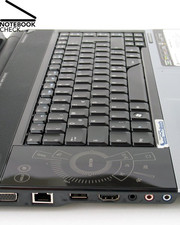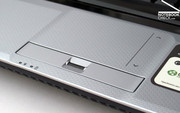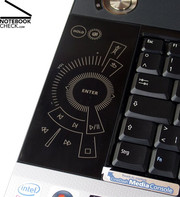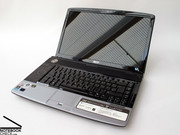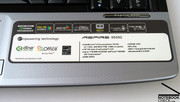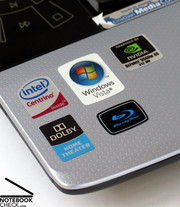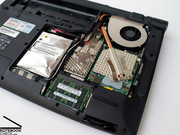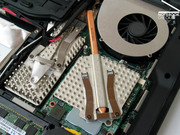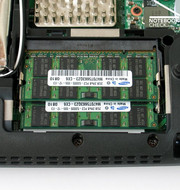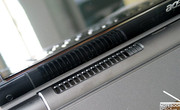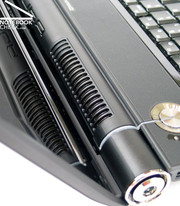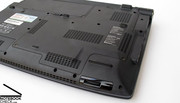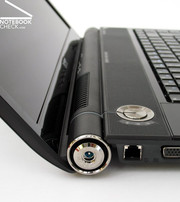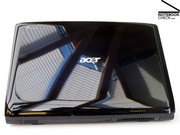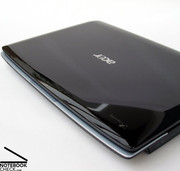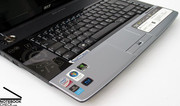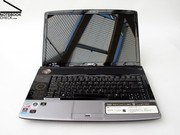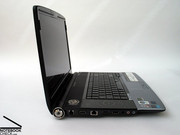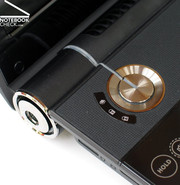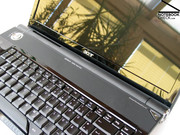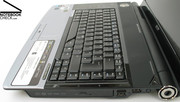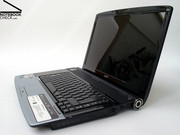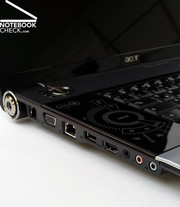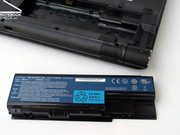Review Acer Aspire 6920G Notebook
The New Middle-Class
Nearly all details were changed with the introduction of the new compact multimedia notebooks by Acer. Packed in a new distinctive Gemstone Blue design, equipped with a 16 inch 16:9 aspect ratio display, and up-to-date hardware, it should, according to Acer, stand as a reference for 'ultimate entertainment'. Therefore, it is furthermore equipped with a Blu-Ray drive and a Dolby certified sound system.
Case
The design of Acer's 5000 series, which is known by the name 'Gemstone' has the potential of being a milestone in terms of Acer's notebook design. We do not like to be reminded to the old Aspire series, whose cases partly heavily suffered from stability problems. The Gemstone design changed a lot. The cases got essentially bigger and the stability improved at the same time. Nevertheless, they finally also look good and clearly distinctive from other brands.
Just one year ago, the introduction of the Gemstone design created a furore by Acer. At this time the Acer 5920G was one of the first models taking advantage of the new design. These days the Acer Aspire 6920G sets a new course. Once again, a new design is introduced, which is obviously based on the previous Gemstone design, but, brings a lot of changes about. The most important difference is the innovative display, which entails a new format of the case.
Overall, the introduction of a 16:9 aspect ratio display was not surprising, because watching films and TV via notebook gained more and more popularity throughout the last months and years. Although wide-screen displays, Blu-Ray respectively HD-DVD, HDMI, and HDCP originate in the film and TV technology, these are nowadays also omnipresent in notebooks.
Although, the new aspect ratio looks unusual at first, the display appears to be rather small, because of its aspect ratio. The new display obviously also gave reason to redesign the hinges, which now dominate the appearance. The case is attached by an elongated duct and the hinges located at its sides are strikingly blue illuminated. This design brings about, that the display folds open down and back and interfaces could, therefore, not be located at the back side. Furthermore, moving the hinges requires some force.
The rest of the appearance is dominated by a not centred keyboard. Left beside the keyboard, there is the newly designed CineDash Media Console. Please refer to the section 'Input Devices' for a detailed discussion of this touch-sensitive console.
The dominating colour of this notebook is black, whereas the glossy lid with illuminated Acer Logo attracts attention.
The design also leverages the silver plastic moulding at the palm rest areas, whose textured surface feels nice to the touch and which seamlessly integrates the touch pad.
The case convinces in terms of stability. Base unit and display are well resistant against applied forces. The flexural rigidity, checked by lifting the notebook at its front edge, is also good. You can neither hear creaking noises, nor observe any immoderate deformations.
The workmanship of the Acer Aspire 6920G cannot be criticised in any way. The only weak point, is the battery, which slightly wobbles.
The hinges do not only look good, they also work properly. They are able to support each position without any problems and hardly see-saw after adjusting the display's position. Although a transport hook is missing, the hinges do not easily move. Despite being unable to completely prevent an unintentionally opening of the notebook, it is not very likely.
Interface Equipment
Because the back side can due to the opening mechanism not be used for interfaces, the interfaces can only be located at the other three sides. But also the front side is free of interfaces and provides only the integrated 6in1 CardReader, which supports SD, MMC, MMCplus, MS, MS PRO, xD.
The optical drive is at the right side near the front. The Aspire 6920G-814G32Bn is equipped with a Blu-Ray Drive by Matshita called BD-CMB UJ-120. After the competition between HD-DVD and Blu-Ray seems to be over, this notebook is best prepared for the future by the Blue-Ray drive. This drive can also burn media, but supports only the 'old' DVD standard.
Furthermore, there are three USB 2.0 port, user-friendly located near the back, at the right side and a Kensington lock at the outside of the hinge. In addition, this notebook is prepared for an antenna, which is only available in notebooks with integrated TV tuner.
All other interfaces are at the left side of the case, these are the power connector at the hinge, modem, LAN, and VGA port, another USB 2.0 port, and a HDMI port with HDCP support. The audio ports, which consist of a headphone port or a S/PDIF out, a microphone port, and a Line-In port, are near the front. Finally, the Acer Aspire is also equipped with an ExpressCard slot at the tapered part of this side.
That's the whole interface equipment, which is except of a FireWire port complete and sufficient. The order of the interfaces is also alright, but, better for right hander, because most of the ports are despite being near the back, at the left side.
Regarding data communication the Acer Aspire 6920G is equipped with a 10/100/1000 Gigabit LAN module by Atheros (AR8121/AR8113), which makes fast wired data transfer via network, and an Intel Wireless module (4965AGN) 802.11a/b/g/n. Provided you have a compatible router, which also support n-standard, the wireless transfer rates are also excellent.
Furthermore, the 6920G is equipped with an built-in 56k modem (V.92), a CIR port (Consumer Infra-red) and a Bluetooth module 2.0+EDR. Furthermore, this notebook comes with a web cam. So, video conferences via Skype are possible.
Acer took security of data and notebook serious and equipped this notebook with a fingerprint reader. The only anti-theft protection is provided by the available Kensington lock which can be utilized with an appropriate locking system.
The Acer Aspire 6920G is not generously equipped with accessories. You'll only find a printed user manual inside the box, but a recovery DVD is missing, the data needed for it is available at the hard disk only.
Input Devices
Whilst the keyboard came with a number of gimmicks in the former Gemstone Design, you could now call the Aspire 6920G mature. The space bar only still attracts attention by a diagonal border to its right adjacent key.
The size of the keys is 18mm x 18mm and the layout is standard, except of extra keys for Euro and Dollar next to the cursor keys. However, we wonder if the focus group of the Aspire 6920G, will need them that frequently, that providing extra keys is justified.
In use, the glazed surface of the keys, which appears to be nearly sticky and does not feel nice to the touch, got obvious at once. Nevertheless, typing itself is user-friendly, but, accompanied by a loud clicking noise. Furthermore, nearly the whole keyboard area gives, so, the quality of the keyboard is overall just moderate. After typing some page of text, we were especially really annoyed by the typing noise.
We especially like that the touch pad is integrated into the notebook in a harmonizing way. Its surface is identical to the one of the palm rest areas and it is just right for moving the finger over it in order to move the mouse pointer. Also response and precision are alright. Both of its buttons are user-friendly and there clicking noise is rather quiet.
However, the most striking and innovate control element of the Acer Aspire 6920G is, nevertheless, the CineDash Media Console. This is a touch sensitive area left beside the keyboard, which can be used to control a number of functions. So, it supersedes separated hot keys. The design of this console basically reminds on science fiction classics, especially on Start Trek.
Although the Media Console did not react at once, this problem suddenly disappeared. According to an Acer technician, this should be a problem of the test sample only.
This input console convinced throughout the test. The single fields react well and also the volume can be easily, quickly, and optically impressing controlled by striking the area designed for it. In order to avoid unintentional activation of some functions, the Media Console comes with a Hold Button at its upper-most position, which can be used to deactivate the input fields.
Display
An important design aspect of the Acer Aspire 6920G is the new 16 inch display with a 16:9 aspect ratio. This display is the first one which is able to utilize the whole screen for film playback, i.e., the black stripes above and below the pictures are missing. Although this sounds great, the question raises whether it makes sense to adjust the aspect ratio of a notebook display to one of current films. After all, a notebook is more than a device for watching DVD, sorry, Blu-Ray films and this aspect ratio might not be ideal for other applications. For good reason there are still notebooks with 4:3 display available.
Anyway, as the Aspire 6920G is according to Acer designed as reference for the ultimate entertainment, a display with an aspect ratio used for films is just right. The display of the reviewed notebooks has a resolution of 1366x768 pixels, so, it does not support full HD resolution (1900x1080 pixels), but only lower resolutions in 16:9 aspect ratio. Alternatively, Acer offers also an Aspire 6920G with a genuine full HD display, i.e. a resolution of 1900x1080 pixels. Of course this has an impact of the price. At the time of writing it costs about 200,- Euro more.
The reviewed display had a very good maximum brightness of 213 cd/m² in its middle upper-most area. Because the brightness diminishes down to only 170.3 cd/m² at the bottom corners, the illumination of 80% is only average. Nevertheless, the average brightness of this display of 190.5 cd/m² is good.
| |||||||||||||||||||||||||
Brightness Distribution: 80 %
Contrast: 188:1 (Black: 1.12 cd/m²)
Subjectively, the picture appears to be bright and the colours strong, whereas also the reflecting display surface contributes to this. Furthermore, it even causes indoors and when displaying bright contents disturbing reflections. The measured black value of 1.12 cd/m² is relatively high, which has of course an impact on the maximum representable contrast. A contrast ratio of 190:1 is rather below-average. That's a pity, especially, because this notebook attracts basically attention by its extraordinary display.
Although its size of 385mm x 275mm makes a mobile use considerable, weighing nearly 3.3. kilogramme it is one of the heavier notebooks of its category. Despite a good brightness, working outdoors is due to a heavily reflecting display not user-friendly. On the one hand the good brightness ensures that the contents stay always legible, but, the heavy reflections are really disturbing.
The viewing angles of the Acer Aspire 6920G's display could also not really convince. Especially vertically, the display quickly darkens respectively whitens with increasing deviation from the ideal viewing angle. Therefore, you'll frequently need to readjust the opening angle in practice. Although the dependence to the viewing angle is not that strong horizontally, you'll face disturbing reflections if the viewing angle is too acute.
Video of Display's Viewing Angles
Performance
It goes without saying that a newly launched multimedia notebook should also be equipped with the most up-to-date hardware. Acer equipped the Aspire 6920G with up-to-date components by Intel and nVIDIA. The reviewed notebook came with a Penryn CPU, a T8100 with 2.1 GHz and 3MB L2-Cache. Although this is currently the least powerful Penryn CPU, its performance is nevertheless better than the one of the equally clocked Merom CPU by Intel. Further information and a comparison of Merom and Penryn CPUs can be found in our special article.
Also the video chip utilizes up-to-date technology. The Acer Aspire 6920G is equipped with a Geforce 9500M GS by nVIDIA, the successor of the 8600M graphics card, which is equipped with 512MB dedicated video memory. Currently, this video card is a middle-class video card of compact multimedia notebooks, but, its reserve capacities are bigger than the one of its predecessor. So far, the benchmark results proved that the 9500M GS is about as powerful as the powerful 8600M GT video chip.
The Acer Aspire follows this trend, but its 3D Mark 2005/2006 benchmark result is clearly worse than of similar equipped notebooks, e.g., the Asus M51S or the Asus F8SN. More powerful CPUs in these models contribute to this result. The Dell XPS M1530 with Geforce 8600M GT graphics card and fast GDDR3 is still unchallenged first
The Acer Aspire 6920G is equipped with above 4096MB DDR2 PC5300 667MHz RAM , provided by two memory models with 2048MB each. The dual-channel mode improves the performance, but only about 3GB can of the available 4 GB RAM can actually be utilized by the pre-installed 32 Bit operating system (Windows Vista Home Premium).
The Aspire 6920G utilizes the currently wide-spread WD3200BEVT hard disk by Western Digital. Its gross capacity is 320GB and its revolution speed is 5400 rpm. The HdTune benchmark test proved a good transfer rate and comparably low access times. The hard disk of the reviewed notebook was already partitioned in a system partition of 144GB capacity and an empty partition of 138GB. It's obvious that these partitions do not add to 320 GB gross capacity. An important part is occupied by recovery data. And also the operating system and various pre-installed more or less useful software, takes up a part. By the way, this Aspire notebook comes with quite a lot of pre-installed software.
The Acer Aspire 6920G reached 4715 points In the PC Mark 2005 benchmark. Therewith, it is clearly behind comparably notebooks, like the Asus M51S or the Asus F8SN. However, this moderate result is put into perspective by the result of the powerful Dell XPS M1530, which is 4374 points and, so, clearly worse.
The Acer Aspire 6920G performs also average in the Cinebench R10 benchmark test . The advantage due to the Penryn CPU gets especially obvious in the picture displaying the rendering benchmark. Although the Geforce 9500M GS can outperform the older 8600M in the OpenGL shading test, optimized user video cards, e.g, the Quadro FX 1600M inside the Dell Precision M6300 perform clearly better.
To, summarize, the office performance of the Acer Aspire 6920G is good, whereas it also has sufficient reserve capacities for the future. This Aspire handles typical applications like Internet and office applications, but, also multimedia applications with ease. If you primarily run CPU demanding applications, e.g., video editing, you should maybe consider choosing a model equipped with the more powerful T9300 CPU, which increases the performance compared to the T8100 CPU.
| 3DMark 2001SE Standard | 20861 points | |
| 3DMark 03 Standard | 10267 points | |
| 3DMark 05 Standard | 6236 points | |
| 3DMark 06 Standard Score | 3584 points | |
Help | ||
| PCMark 05 Standard | 4715 points | |
Help | ||
| Cinebench R10 | |||
| Settings | Value | ||
| Shading 32Bit | 2725 Points | ||
| Rendering Multiple CPUs 32Bit | 4102 Points | ||
| Rendering Single 32Bit | 2217 Points | ||
Gaming Performance
The Acer Aspire 5920G was popular, because of its good equipment and because it was therewith fit for computer games. We expect the like for the Aspire 6920G too. Its 3D Mark 2005/2006 benchmark results were good, however, the test of current games in practice is even more interesting.
The ego shooter Crysis by EA games forces even some high-end gaming notebooks onto its knees. Obviously, the same is true for the Aspire 6920G, which the benchmark results prove. It can only reach good frame rates of 40-50 fps with a resolution of 1024x768 pixels and low details. The frame rate decreases down to 30 fps with native resolution of 1366x768 and otherwise identical settings. Crysis is to some degree playable with these settings (30-35 Fps), however, the quality of the graphics could not really convince.
The results when running World in Conflict are absolutely better. The benchmark results are with medium details (DirectX 9) between 23 and 27 fps. However, with high details they diminish to below 20 fps. We ran a multiplayer match 3 vs. 3 at the seaside map to test the performance in practice and the Acer Aspire 6920G reached 35-60 fps and so, World in Conflict is overall well playable.
The performance of Call of Duty 4 - Modern Warfare was also alright. When we started to play the first mission of a single-player story with a resolution of 1024x768 pixels, deactivated anti-aliasing and otherwise standard settings, we measured a frame rate of 30-45 fps. In native resolutions with otherwise identical settings the performance decreased to 25-40 fps.
Even the frame rates of Unreal Tournament 3 (Deathmatch, Map: Heat-Ray) of 35-55 fps with a resolution of 1024x768 pixel (standard detail) to 25-45 fps with native resolution of 1366x768 pixels is playable, but not outstanding.
The real-time strategy game Supreme Commander - Forged Alliance tested with a multi-player game of 2 vs. 2 with medium presets and a resolution of 1024x768 reached 15-20 fps. Decreasing the details to low improved the frame rate to 25-30 fps. However, the quality of the graphics is clearly worse with low details. The moderate result with Supreme Commander should be mainly caused by the T8100 CPU, because this game demands much calculation power. For this purpose you should consider to choose the more powerful T9300 CPU.
Emissions
Loudness
It is clear that this notebook can due to the offered performance not run absolutely quietly. Nevertheless, we feel that the Aspire 6920G is a little bit too loud, if the load is low, e.g., in idle mode or when running undemanding office applications. Although the measured noise level of 36.8 dB(A) is de facto alright, the noise is subjectively annoying.
The maximum noise level under load and when running games was 41.9 dB(A), which is average. But, considering this is an entertainment notebook, the noise during DVD playback of 44.2 dB(A) is clearly too loud.
Noise level
| Idle |
| 36.8 / 36.8 / 36.8 dB(A) |
| HDD |
| 37.4 dB(A) |
| DVD |
| 44.2 / dB(A) |
| Load |
| 41.9 / 44 dB(A) |
 | ||
30 dB silent 40 dB(A) audible 50 dB(A) loud |
||
min: | ||
Temperature
The heating of the case is alright under load. Neither the top nor the bottom side got considerably warmer. The maximum temperature of 33.2°C was measured at the bottom side of the notebook.
(+) The maximum temperature on the upper side is 32.2 °C / 90 F, compared to the average of 36.9 °C / 98 F, ranging from 21.1 to 71 °C for the class Multimedia.
(+) The bottom heats up to a maximum of 33.2 °C / 92 F, compared to the average of 39.2 °C / 103 F
(+) The palmrests and touchpad are cooler than skin temperature with a maximum of 29.1 °C / 84.4 F and are therefore cool to the touch.
(±) The average temperature of the palmrest area of similar devices was 28.7 °C / 83.7 F (-0.4 °C / -0.7 F).
Speakers
The Acer Aspire is decorated with many logos, which strike a good sound quality. These cover hints like Dolby Home Theater or Virtual Surround Sound. Also the back side is decorated by a big imprint labelled TUBA. It hints on an integrated subwoofer, which should improve the sonority.
We tried a number of different types of music and the speakers, located above the keyboard, did quite well. Only the TUBA was too quiet, and could be definitely a little bit louder.
Battery Runtime
The Acer Aspire 6920G is equipped with a 4400 mAh Li-Ion battery (48.8 Wh), which should make a passable runtime possible. The maximum runtime measured with the BatterEater Readers test (energy saving mode, WLAN off, minimum brightness) was 165 minutes. Under load, measured by the BatteryEater Classic test (top performance, maximum brightness, WLAN, and Bluetooth on) the runtime of the Aspire 6920G was 79 minutes, which is also not exciting.
In practice, i.e, DVD playback (profile balanced, maximum brightness, WLAN, and Bluetooth off) the runtime is 116 minutes, which is just the quota for a multimedia notebook.The result of 152 minutes with wireless WLAN operation (energy saving profile, adjusted brightness, WLAN on, Bluetooth off) is average.
To summarize, the battery life is overall average for this notebook category, but, could be quickly too small, if you intend to increase the mobile use.
| Off / Standby | |
| Idle | |
| Load |
|
Key:
min: | |
Verdict
The Acer Aspire 6920G proved to be a good notebook in our test, whereas especially the changed details scored points. The case was completely redesigned and is now robust, compact, and also looks nice.
While you'll need some time to get used to the way typing feels and to the nearly sticky surface of the keys, the new input console, called CineDash Media Console is another highlight regarding design and ergonomics. It makes a number of inputs easy and enables to quickly and strikingly control the media player functions.
The new 16:19 aspect ratio display with HD resolution of 1366x768 pixels makes this notebook especially attractive. In combination with the Blu-Ray drive you can watch films in best quality, accompanied by a good sound quality. While the display's brightness is good, its contrast is only below-average and the viewing angles are moderate.
Being a multimedia notebook the hardware equipment of the Aspire 6920G is good. The Core 2 Duo Penryn T8100 CPU with 2.1 GHz and the Geforce 9500M GS ensure good benchmark results and also make the Acer Aspire 6920G to some extent fit for current computer games.
Unfortunately the noise of the fan is a little bit too loud, especially if operated with low load. In return, the surface temperatures of the Aspire 6920G are very low.
The battery runtime ranges from a little more than one hours under load to nearly three hours maximum runtime. The runtime when using WLAN is a little more than two hours which should allow mobile operation to some extent.





